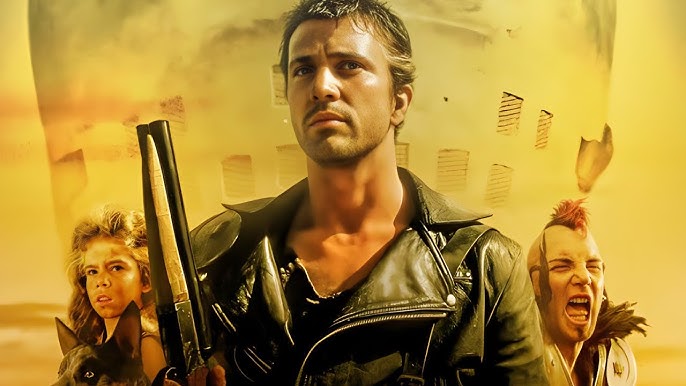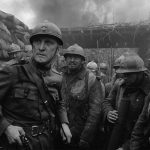The Road Warrior (1982)

Released in 1982, The Road Warrior—also known as Mad Max 2—is a landmark film in the genre of post-apocalyptic action, directed by the visionary filmmaker George Miller. As the second installment in the Mad Max series, the film has cemented its place as a seminal work that continues to influence action cinema. Featuring Mel Gibson in his iconic role as Max Rockatansky, The Road Warrior immerses viewers in a dystopian world where societal structures have collapsed, and survival is a daily struggle.
Set in a bleak and desolate future, The Road Warrior transports audiences to a world ravaged by environmental catastrophe and societal collapse. The film’s setting is a vast wasteland where the remnants of civilization cling to existence amidst a backdrop of desolation and decay. This setting is not merely a stage but an integral character in itself, contributing significantly to the film’s atmosphere of relentless hopelessness and unyielding danger.
The story follows Max Rockatansky (Mel Gibson), a lone drifter and former police officer, who roams the wasteland in search of fuel and supplies. Max is introduced as a hardened survivor, hardened by the loss of his family and the brutal realities of his world. The plot intensifies when Max encounters a small community of survivors, who are under siege by a gang of marauders led by the menacing Humungus (Kjell Nilsson). The community is fiercely protecting a fuel refinery, which is crucial for their survival.
Max’s reluctant involvement with the community stems from his desire to trade for fuel, but he soon becomes entangled in their struggle for survival. As the marauders’ attacks become more aggressive, Max must navigate a treacherous landscape of violence and betrayal, ultimately deciding whether to aid the beleaguered community or continue his solitary existence.
George Miller’s direction in The Road Warrior is a masterclass in creating tension and excitement within a dystopian setting. Miller’s vision is characterized by its raw and unfiltered portrayal of a post-apocalyptic world, where the relentless pursuit of survival drives the narrative. His innovative approach to action filmmaking is evident in the film’s high-octane sequences and dynamic set pieces.
The cinematography, handled by Dean Semler, complements Miller’s directorial style by capturing the vastness and desolation of the wasteland. Semler’s use of sweeping landscape shots and intense close-ups enhances the film’s sense of scale and immediacy. The film’s action sequences, particularly the high-speed chases and vehicular combat, are shot with a gritty realism that heightens the tension and excitement.
The Road Warrior explores several themes that resonate through its high-octane narrative. Among the central themes are survival, community, and the collapse of societal norms.
Survival is the primary driving force in the film. The desolate environment and the constant threat of violence create a world where every action is driven by the need to endure. Max’s journey is emblematic of the struggle to maintain one’s humanity in the face of overwhelming odds. His character embodies the resilience and resourcefulness required to navigate a world where traditional structures have disintegrated.
The theme of community is also significant in The Road Warrior. The small band of survivors who inhabit the fuel refinery represents a fragile hope for rebuilding some semblance of society. Their struggle against the marauders highlights the importance of unity and cooperation in the face of external threats. The film explores the concept of community as both a source of strength and a potential vulnerability.
The collapse of societal norms is a recurring theme throughout the film. The wasteland is populated by characters who have adapted to a world where traditional laws and ethics no longer apply. The film portrays a society where violence and anarchy reign supreme, illustrating the breakdown of established order and the emergence of a new form of lawlessness.

Mel Gibson’s portrayal of Max Rockatansky is a defining element of The Road Warrior. Gibson’s performance captures Max’s transformation from a solitary wanderer to a reluctant hero. His portrayal conveys the character’s emotional depth and internal conflict, making Max a compelling and relatable protagonist.
Kjell Nilsson’s performance as Humungus, the leader of the marauders, is both menacing and memorable. Nilsson brings a sense of physicality and intensity to the role, creating a formidable antagonist who poses a significant threat to the community.
The supporting cast, including Bruce Spence as the Gyro Captain and Virginia Hey as the Warrior Woman, adds depth to the film’s ensemble. Their performances contribute to the film’s rich tapestry of characters and enhance the overall narrative.

The Road Warrior has had a lasting impact on the action genre and post-apocalyptic cinema. Its innovative approach to action filmmaking, characterized by its intense vehicular combat and high-speed chases, has influenced numerous films and directors. The film’s depiction of a dystopian world, coupled with its memorable characters and groundbreaking special effects, has cemented its status as a classic in the genre.
The film’s influence can be seen in the subsequent Mad Max films, including the critically acclaimed Mad Max: Fury Road (2015). The Road Warrior set a new standard for action cinema, combining thrilling action with thought-provoking themes and a distinctive visual style.

The Road Warrior (1982) is a landmark in the genre of post-apocalyptic action cinema, directed by George Miller and featuring Mel Gibson in an iconic role. The film’s portrayal of a dystopian world, combined with its innovative action sequences and thematic depth, has made it a seminal work that continues to influence the genre. Through its exploration of survival, community, and the collapse of societal norms, The Road Warrior remains a powerful and enduring example of action filmmaking that resonates with audiences and continues to inspire filmmakers around the world.










